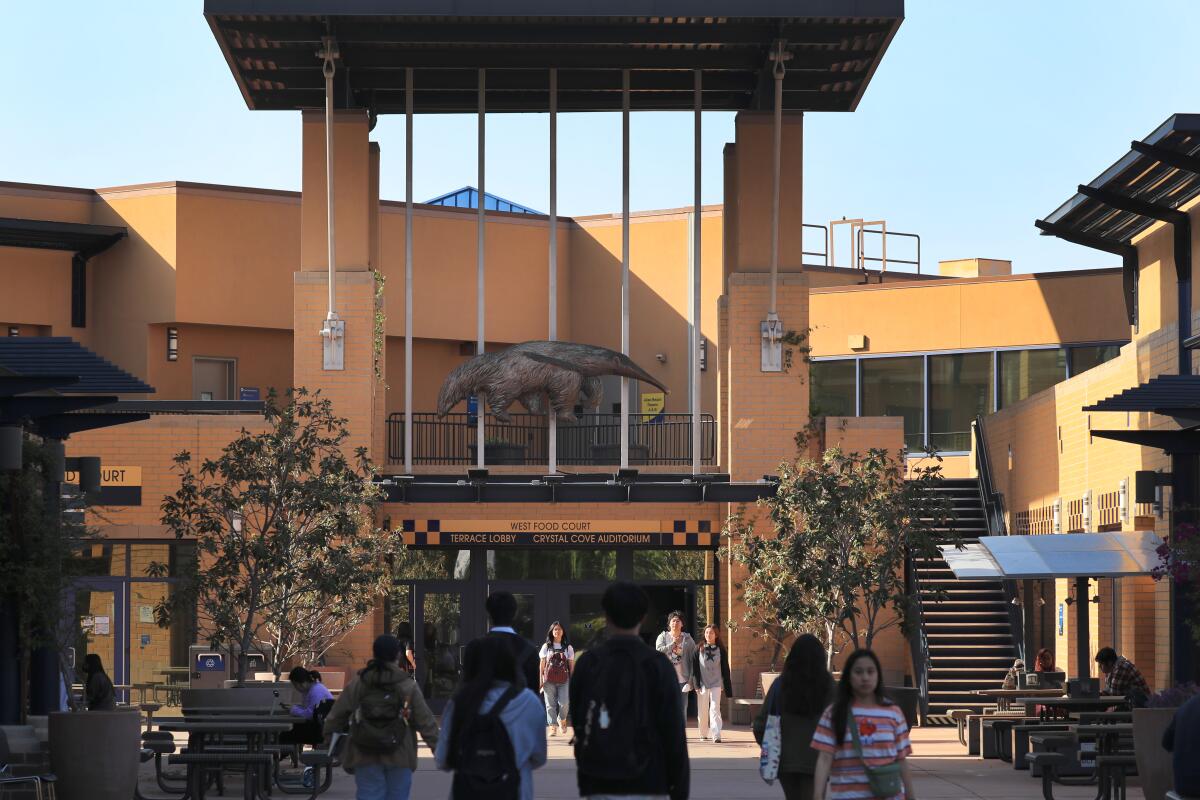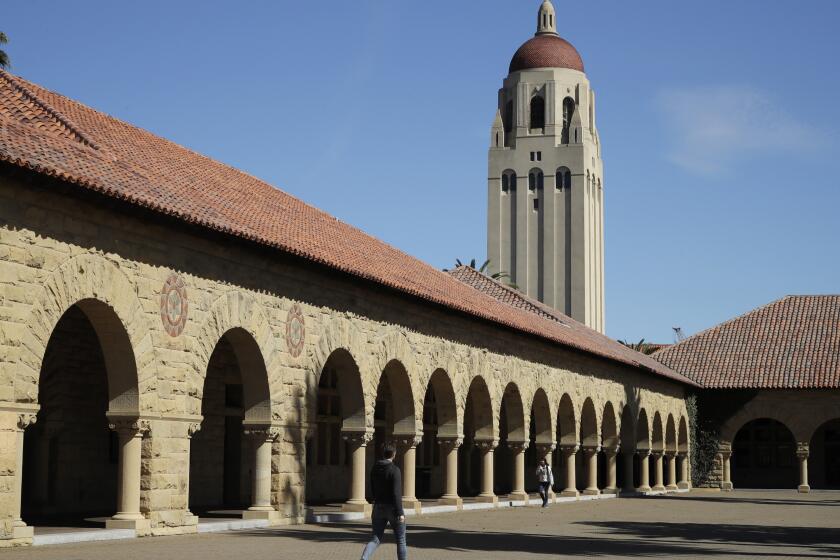UC applications rise for fall 2024, with gains in diversity and transfer applicants

The University of California drew a quarter-million applications for fall 2024, an increase over last year powered by a significant rebound in community college transfer applicants and more in-state residents of increasingly diverse backgrounds, according to preliminary data released Wednesday.
The number of California first-year applications increased to 134,053, a 1.4% rise over last year’s preliminary data, with gains at eight of nine UC undergraduate campuses. UCLA, UC San Diego and UC Irvine drew the most first-year applications from Californians, while UC Berkeley’s numbers dropped slightly over last year.
Applications from out-of-state residents fell, possibly a reflection of state goals focused on keeping more seats for Californians. Texas sent the most applicants, but a state-by-state breakdown showed no pattern of higher interest from students in red states that have adopted strict antiabortion laws after the U.S. Supreme Court struck down its Roe vs. Wade ruling in 2022. International students increased slightly.
But the most eye-catching development — one hailed by campus admission leaders — was the robust growth in transfer applications, which had fallen significantly during the last two years as community college enrollments plunged during the pandemic and its aftermath. Transfer applications grew to 43,543, a 10.6% increase over last year, including 34,668 from California Community College students.
Latinos were again the largest group of applicants, at 39%, with Asian Americans at 30%, whites at 20%, Black students at 7%, American Indians at 1% and Pacific Islanders at less than 1%. Black applicants saw the strongest growth, increasing in number by 7%, with gains of 2.5% for Latinos and 1.9% for American Indians, the term UC uses in its demographic data.
UC’s ability to continue increasing historically underrepresented student groups without race-based affirmative action — banned in California in 1996 and struck down by the high court last year — is due to its comprehensive review process, campus efforts to create partnerships with community groups embedded in underserved neighborhoods and robust financial aid that reduces the cost of college, the university said in a statement.
UC also drew slightly more low-income applicants for first-year seats, growing to 40% compared with 39.9% last year. The number of students receiving federal Pell Grants had dropped for several years, raising concerns that students with the greatest financial need were not able to access a UC education even if well-qualified.
“We are pleased to see such an outstanding pool of students from a wide range of backgrounds and life experiences,” UC President Michael V. Drake said in a statement. “Prospective students and their families recognize that a degree from the University of California sets them up for lifelong career success. The increase in applications underscores the quality of the educational experience and the long-term social mobility a UC education can provide underrepresented students.”
A new California legislative effort to ban state financial aid to colleges and universities that give admissions preferences to children of alumni and donors could hit USC, Stanford.
Although UC campuses have pledged to increase seats for new California students as part of their compact with Gov. Gavin Newsom, the higher application numbers may well result in lower admission rates — especially at the most competitive campuses. In 2023, for instance, UCLA admitted 9.5% of California first-year applicants and UC Berkeley, 15.1%.
Jim Rawlins, associate vice chancellor of enrollment management at UC San Diego, raised that concern even as he said he was gratified by the growing interest in his campus.
“I never want to celebrate an increase in any way that’s mindless of the fact that it means we will very likely have to deny more people as a result,” he said. “One of the main things that happens with that phenomenon is that fear of not getting in tends to disproportionately discourage students who are first generation to go to college or low income or at disadvantaged, lower-funded schools. And we just hate to see those students not apply.”
Still, UC San Diego received more first-year applications from Californians of Black, Latino and American Indian descent for fall 2024 over last year. Overall, the campus saw gains in California first-year applicants to 88,392 applications, up 4.1%, and transfers to 19,371, a 12.3% increase.
The turnaround in transfer applications fueling the applicant growth reflected not only the pandemic recovery and a rebound in community college enrollments but also growing efforts to improve pathways from community colleges to UC campuses. All campuses drew more transfer applications for fall 2024 over last year except UC Merced, with UCLA, UC Irvine, UC San Diego and UC Berkeley all receiving more than 20,000 each.
Several UC campuses extended their transfer application deadline this year by six weeks to Jan. 15. UC Santa Cruz received 600 to 800 additional applications while UC San Diego drew as many as 900 more because of the extension, campus officials said.
UC also worked with the California Community Colleges system to receive contact information for all two-year students interested in transferring to a four-year institution, allowing campuses to reach out to them earlier in the admission cycle.
UC Santa Cruz, for instance, emailed about 500,000 potential transfer students last fall to congratulate them on their educational journeys and offer help in course planning, financial aid issues and other support, said Michelle Whittingham, associate vice chancellor of enrollment management. The number of transfer applications overall grew to 12,218 — a 9.6% increase — for fall 2024 while those for first-year seats increased to 71,697, a 4.2% rise.
“Seeing the resiliency of the students as those transfer numbers start to recover is really exciting,” Whittingham said.
At UCLA, the rebound in transfer applicants was also applauded as a standout development this year. The Westwood campus topped all campuses in transfer applications — 27,150, a 13.3% increase. UCLA also drew the largest number of first-year applications — 146,250, all but assuring its position as the most sought-after university in the nation. California residents applying to UCLA grew slightly to 92,290, a 1.7% increase. The number of applicants from out of state and overseas declined slightly.
“Our goal overall, especially as it relates to freshmen, isn’t about getting more applications — we’ve got plenty,” said Gary Clark, UCLA associate vice chancellor of enrollment management. “It’s more of a focus on the makeup of the applicant pool. Seeing the community colleges starting to rebound and build back their enrollment to getting close to pre-pandemic levels and then seeing that really show up in our applicant pool this year, is exciting.”
UC Davis saw robust growth in applicants in all categories. The number of first-year applicants increased to 98,834, a 4.4% increase, and transfers grew to 16,515, a 12% rise. Officials have said that one recruiting pitch is the area’s greater affordability compared with other UC campuses in the Bay Area and California coastal areas, some of the state’s priciest real-estate markets.
UC Irvine’s total applications for first-year seats grew to 122,661, up by 1.3%. Transfer applicants grew to 25,187, a 14% increase.
“It was a real strong year for us, and that’s really not just a testament to the hard work of our staff, but testament of the growing reputation of the campus,” said Dale Leaman, executive director of undergraduate admissions.
Irvine specifically sought to raise its profile in areas outside California, with targeted recruitment in the Pacific Northwest and the Northeast. Officials not only played up the campus’ academic and research excellence, but also the area’s safety and amenities — such as nearby Disneyland and beautiful Orange County beaches, said Bryan Jue, senior director of outreach and communications.
At UC Santa Barbara, first-year applicants from California grew to 75,523 but declined slightly for nonresident students, amounting to a total 110,236. Transfer applicants overall grew to 18,410, an 8% rise.
Lisa Przekop, UC Santa Barbara associate director of admissions, said the full return of campus bus tours from L.A. to Santa Barbara, which were canceled during the pandemic, has helped local recruitment. Many Los Angeles high school students who have never been to Santa Barbara often think the campus is “really far away” — rather than just 90 minutes, she said.
“They can see that it wasn’t a very long bus ride, and then they get to see the campus,” she said. “Santa Barbara is one of those campuses that if you see it, it makes a big difference.”
Another notable development among this year’s applicants, Przekop said, was the steep drop in computer science majors, which declined by about 1,600 to 9,173. She said UC admissions officials told high school counselors at a conference last year that the highly competitive and rigorous field is best suited for those with a passion for it, rather than a casual interest. At UC Santa Barbara, for instance, the admission rate is only 10% for computer science majors compared with about 30% overall, she said.
UC Riverside also saw growth, receiving 57,420 applications for first-year seats and 12,042 for transfer spots. UC Merced drew 29,351 first-year applications — a 14% increase — but transfer applications declined slightly to 3,589.
“These application numbers confirm we are headed in the right direction,” Han Mi Yoon-Wu, UC associate vice provost for undergraduate admissions, said in a statement. “The University of California’s unparalleled combination of affordability and high-quality education continues to attract talented applicants.”
More to Read
Sign up for Essential California
The most important California stories and recommendations in your inbox every morning.
You may occasionally receive promotional content from the Los Angeles Times.












